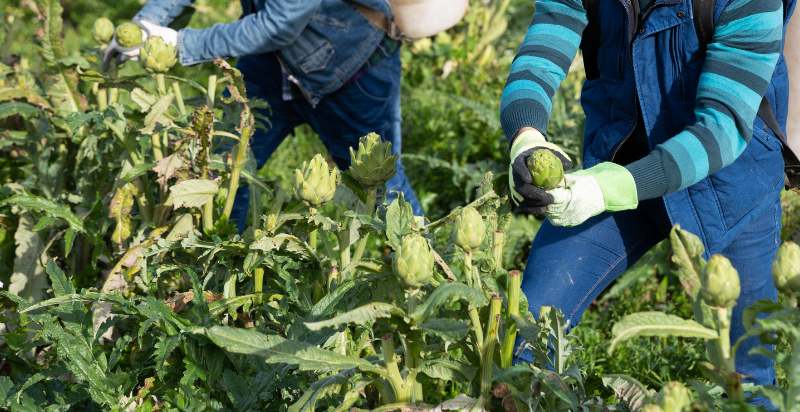Are artichokes as mysterious and unusual-looking plants as they seem? Artichokes have been around for centuries but are still relatively unknown to modern consumers. This article will answer your questions about the artichoke plant, its nutritional benefits, and how to prepare it.
What is Artichoke?
Artichoke is a type of thistle that belongs to the Asteraceae family. It is native to the Mediterranean region but can also be found in other parts of the world. Artichokes have a prickly exterior and a tender edible interior once cooked. The leaves, stem, and heart of an artichoke are all edible; however, its globe-shaped immature flower bud is the most popular part used for cooking.
Artichokes are high in fiber, vitamins C and K, folate, magnesium, and potassium, which provide various health benefits, including improved digestion, reduced cholesterol levels, and better heart health. When cooked properly, they offer a unique flavor profile with slightly bitter undertones of nutty or grassy notes contrasted by sweet and tender texture.
History of Artichoke:
The artichoke is thought to have originated in Sicily, Italy, and is thought to have been eaten by ancient Greeks and Romans. Artichokes were brought to the United States in the late 1800s but became widely available in the 1920s. Today, artichokes are grown commercially in California and Arizona.
Types of Artichoke:
There are two main types of artichokes – the Green Globe Artichoke and the Jerusalem Artichoke. The Green Globe is the most common type found in grocery stores and is a deep green color with a thick stem. The Jerusalem Artichoke, also known as the “sunchoke,” has a lighter color and smaller size.
Description of Artichoke:
Artichokes are a type of flower that grows on a bush. The edible part of an artichoke is the immature bud before it blooms into a bright purple and yellow flower. Artichokes can range from small to large but typically measure around three inches in diameter. The exterior of the bud is covered in sharp, pointed spines. The inside contains a soft heart and edible leaves called “scales.”
Cultivation of Artichoke:
Artichokes are grown in a variety of climates but have specific needs. Artichokes grow best in soil with good drainage and require plenty of water to stay healthy. The plants should be harvested when the buds are still tight, and the scales are still moist.
Nutritional Benefits of Artichoke:
Artichokes contain a variety of vitamins, minerals, and antioxidants. They are high in fiber and low in calories, making them an ideal snack or side dish. Artichokes are also a great folate, magnesium, potassium, and vitamin C source.
Nutritional Value of Artichoke:
Artichokes are an excellent source of fiber, vitamins A and C, folate, magnesium, potassium, phosphorus, and iron. They also contain antioxidants that can help to protect the body against free radical damage. Artichokes are low in calories and a great source of vegetarian protein.
Health Benefits of Artichoke:
Artichokes are high in fiber and can help to reduce cholesterol levels, decrease inflammation, and promote digestion. The antioxidants in artichokes can help protect the body from cell damage and may even reduce the risk of certain cancers. Artichokes also contain prebiotics which can help improve gut health.
How to Plant Artichokes?
Artichokes are a great vegetable in your garden and can be very rewarding to grow. This article will look at how to plant artichokes properly and what you need to consider when doing so.
- Step One: Before planting artichokes, ensure that the area you plan to grow them in has full sun and well-drained soil. This will help ensure that the artichokes have enough sunlight and water to grow properly.
- Step Two: Purchase artichoke seeds or seedlings from a reputable garden center or nursery. Make sure that the plants are healthy and free of disease before bringing them home.
- Step Three: When ready to plant your artichokes, prepare the soil by tilling it and adding compost or fertilizer for nutrients. You can also add mulch around the base of the plants to help retain moisture and keep weeds away.
- Step Four: Place your artichoke plants into individual holes about 8 inches deep and wide, ensuring the roots are spread out, and the crown is level with the soil.
- Step Five: Once planted, give your artichokes plenty of water and fertilize them regularly. Monitor your plants for signs of pests or disease, and take steps to treat them if necessary.
- Step Six: Harvesting your artichokes is easy; wait until the buds are full-sized but still tightly closed and cut them off at their stems. Enjoy!

How to Care for Artichoke Plant?
Once your artichokes are planted, you will need to maintain them with proper care. Here are a few tips on how to take care of your artichoke plants:
- Water regularly – Artichoke plant need at least an inch of water per week during their growing season (typically from early spring until late fall). Make sure to water deeply and avoid wetting the leaves.
- Fertilize – Feed your artichokes monthly with a balanced fertilizer like compost or manure tea for best results.
- Mulch – Apply mulch around the base of each plant to help retain moisture in dry weather, suppress weeds and reduce competition from other plants in the garden.
- Prune – Pruning your artichoke plants can help to improve airflow and encourage more flowering and fruiting.
- Monitor for pests or disease – Keep an eye out for any signs of infestation (such as aphids or mites), and take steps to treat them if necessary.
Artichokes are a great addition to any garden, but they require special attention to thrive. Following the tips outlined above will help you get the most out of your artichoke plants, so you can enjoy their delicious fruits for years to come.

Preventions From Pests and Diseases:
Pests and diseases can be a problem for artichoke plants, so it is important to take preventive measures to ensure that they don’t become an issue. Here are some tips on how to prevent pests and diseases in your artichokes:
- Plant in the right spot – Choose a planting site with full sun and well-drained soil, as this will help reduce the risk of fungal or bacterial infections.
- Space plants appropriately – Give each plant enough room to grow without overcrowding, which will help improve airflow and discourage disease spread.
- Monitor regularly – Keeping an eye on your plants can help you catch any signs of infestation before they become a problem.
- Remove diseased plants – If any of your artichoke plants show signs of disease, it is best to remove them immediately to avoid spreading the infection to other plants in the garden.
- Use organic controls – To help reduce pests and diseases, you can use natural remedies like neem oil or insecticidal soap instead of chemical pesticides or fertilizers.
Following these simple tips can minimize the risk of disease and pest infestations in your artichoke plants, allowing them to thrive for years.
How to Harvest Artichoke Plant?
Harvesting artichokes is easy; wait until the buds are full-sized but tightly closed and cut them off at the stem. Harvesting in the morning is best, as this is when their flavor will peak. To store your freshly picked artichokes, put them in a plastic bag and place them in the refrigerator for up to two weeks.
To get maximum yield from each plant, you can trim off any smaller buds that aren’t fully grown. These can be cooked up just like regular artichokes or saved and replanted to produce more flowers next season.
Enjoy! You have now successfully harvested your homegrown artichokes. You can enjoy these delicious vegetables for years to come with proper care and maintenance.

How to Store Home-Grown Artichokes?
Storing home-grown artichokes is easy and will help to keep them fresh for longer. After harvesting, it is important to cool the artichokes as quickly as possible; this can be done by placing them in an airtight bag and storing them in the refrigerator for up to two weeks. If you need to store your artichokes for longer, you can also freeze them.
To do this, blanch the artichoke buds in boiling water for 3 minutes before transferring them to an ice bath. Once cooled, dry off any excess moisture and place them into freezer bags or containers before freezing. When ready to use, thaw the frozen artichokes overnight in the refrigerator before cooking or using them in your favorite recipes.
By following these simple steps, you can ensure that your home-grown artichoke will stay fresh and delicious for months to come!
These tips should help ensure that your homegrown artichokes remain healthy and productive for many seasons. With a little care and attention, you’ll be able to enjoy the fruits of your labor all season long – so get out there and start growing!
How to Use Artichokes?
Home-grown artichokes are incredibly versatile and can be used in various dishes. From soups and salads to portions of pasta, pizzas, and sides – there’s no limit to what you can make with these delicious vegetables. Artichokes are also full of vitamins and minerals, making them a great addition to any meal.
The best way to enjoy your freshly harvested artichokes is by steaming them until tender; this will help retain the vegetable’s natural flavor. Once cooked, you can use artichoke hearts as an appetizer or side dish or stuff them with a savory filling for entrees like stuffed shells or vegetarian lasagna.
No matter how you use your home-grown artichokes, you’ll surely enjoy their unique flavor and texture. So get out there and start harvesting!
And that’s it – you now know how to care for artichoke plants, harvest them, and store them for later use. With these tips in mind, you can ensure a successful crop of these delicious vegetables every season. Enjoy!

Potential Risks from Artichoke Plants:
While artichoke plants are generally considered safe to cultivate and consume, some potential risks should be considered. Pesticide use is one of the biggest concerns with artichoke cultivation, as excessive or improper use can contaminate the plant and surrounding environment.
Additionally, some people may experience an allergic reaction when consuming raw artichokes; it’s important to keep this in mind if you are harvesting your crop.
Finally, certain parts of the artichoke plant (such as its leaves) contain a compound called cynarin, which can interfere with cholesterol-lowering medications. It’s always best practice to consult with your healthcare provider before eating any part of the artichoke plant.
By being aware of the potential risks associated with cultivating artichoke plants, you can help to ensure that your crop remains safe and healthy for years to come.
With this information in hand, you now know everything there is to know about growing and caring for home-grown artichokes. From planting and harvesting to storage and consumption, you’re ready to start enjoying these delicious vegetables at home.
Conclusion
Growing artichokes at home is a rewarding experience that can provide you with delicious and nutritious vegetables for years to come. With the proper care and attention, your homegrown artichokes will remain healthy and productive for many seasons. Just remember to be mindful of potential risks associated with pesticide use and consuming raw artichoke parts — and above all else, enjoy!
- Everything You Wanted to Know About Red Tamarillos - June 2, 2025
- A Guide to Tulips: Everything You Need to Know & More… - June 2, 2025
- Guanabana: Description, Flavor, Benefits, And Uses - May 27, 2025

2 thoughts on “What Are Artichokes? How to Plant, Grow, and Harvest Artichokes”
Comments are closed.